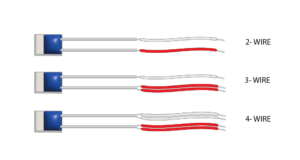2-Wire, 3-Wire, or 4-Wire RTDs: What’s the Difference?
RTDs are commonly applied for temperature measurements in industrial and laboratory environments. The basic RTD classification includes: 2-wire, 3-wire, and 4-wire configurations. All of these affect how lead wire resistance compensation is provided to RTD and further impact the degree of precision on temperature readings. In this blog, we will explore these three RTD configurations […]
What are the Differences Between Thermocouple Types?
Thermocouples are one of the most significant temperature sensors used by various industries to measure temperatures with high accuracy and efficiency. Thermometer types vary through unique combinations of metals that affect temperatures, accuracy, and suitability in different conditions of different types. There are eight common types of thermocouples, namely: K, J, T, E, N, S, […]
Which is Better? Thermocouple, Thermistor, or RTD?
Which temperature sensor to choose – a thermocouple, a thermistor, or an RTD (Resistance Temperature Detector)? This would certainly depend on the particular application, the temperature range, the accuracy desired, the response time needed, and the cost. Each has its pros and cons and is best suited to specific uses and environments. Here’s a breakdown […]

